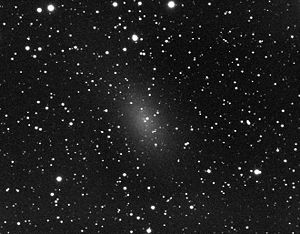- Dwarf spheroidal galaxy
-
Dwarf spheroidal galaxy (dSph) is a term in astronomy applied to low luminosity galaxies that are companions to the Milky Way and to the similar systems that are companions to the Andromeda Galaxy M31. While similar to dwarf elliptical galaxies in appearance and properties such as little to no gas or dust or recent star formation, they are approximately spheroidal in shape, generally lower luminosity, and are only recognized as satellite galaxies in the Local Group.[1]
While there were nine "classical" dSph galaxies discovered up until 2005, the Sloan Digital Sky Survey has resulted in the discovery of 11 more dSph galaxies—this has radically changed the understanding of these galaxies by providing a much larger sample to study.[2]
Recently, as growing evidence has indicated that the vast majority of dwarf ellipticals have properties that are not at all similar to elliptical galaxies, but are closer to irregular and late-type spiral galaxies, this term has been used to refer to all of the galaxies that share the properties of those above. These sorts of galaxies may in fact be the most common type of galaxies in the universe, but are much harder to see than other types of galaxies because they are so faint.
Because of the faintness of the lowest luminosity dwarf spheroidals and the nature of the stars contained within them, some astronomers suggest that dwarf spheroidals and globular clusters may not be clearly separate and distinct types of objects.[3] Other recent studies, however, have found a distinction in that the total amount of mass inferred from the motions of stars in dwarf spheroidals is many times that which can be accounted for by the mass of the stars themselves. In the current predominantly accepted Λ Cold Dark Matter cosmology, this is seen as a sure sign of dark matter, and the presence of dark matter is often cited as a reason to classify dwarf spheroidals as a different class of object from globular clusters (which show little to no signs of dark matter). Because of the extremely large amounts of dark matter in these objects, they may deserve the title "most dark matter-dominated galaxies" [4]
See also
- Galaxy
- Dwarf galaxy
- Dwarf elliptical galaxy
- Galaxy morphological classification
- Galaxy formation and evolution
- Groups and clusters of galaxies
- Irregular galaxy
- Local group
- List of nearest galaxies
- Dark galaxy
External links
References
- ^ Mashchenko, Sergey; Sills, Alison; Couchman, H. M. (March 2006), "Constraining Global Properties of the Draco Dwarf Spheroidal Galaxy", The Astrophysical Journal 640 (1): 252–269, arXiv:astro-ph/0511567, Bibcode 2006ApJ...640..252M, doi:10.1086/499940
- ^ Simon, Josh; Geha, Marla (November 2007), "The Kinematics of the Ultra-faint Milky Way Satellites: Solving the Missing Satellite Problem", The Astrophysical Journal 670 (1): 313–331, Bibcode 2007ApJ...670..313S, doi:10.1086/521816
- ^ van den Bergh, Sidney (November 2007), "Globular Clusters and Dwarf Spheroidal Galaxies", MNRAS (Letters), in press 385 (1): L20, arXiv:0711.4795, Bibcode 2008MNRAS.385L..20V, doi:10.1111/j.1745-3933.2008.00424.x
- ^ Strigari, Louie; Koushiappas, et al; Bullock, James S.; Kaplinghat, Manoj; Simon, Joshua D.; Geha, Marla; Willman, Beth (September 2007), "The Most Dark Matter Dominated Galaxies: Predicted Gamma-ray Signals from the Faintest Milky Way Dwarfs", The Astrophysical Journal 678 (2): 614, arXiv:0709.1510, Bibcode 2008ApJ...678..614S, doi:10.1086/529488
Galaxy Morphology - Elliptical galaxy
- Lenticular galaxy
- (unbarred
- barred)
- Spiral galaxy
- ([barred
- intermediate
- unbarred]
- [grand design
- flocculent
- Magellanic spiral])
- Irregular galaxy
- Dwarf galaxy
- Dwarf elliptical
- Dwarf spheroidal
- Dwarf spiral)
- Giant galaxy
- (Giant elliptical
- D-galaxy
- cD-galaxy)
Structure Active nuclei Energetic galaxies - Starburst galaxy
- (Wolf–Rayet
- BCD
- pea)
- LIRG
- (ULIRG
- HLIRG)
- LAE
Interaction Lists See also - Dark galaxy
- Intergalactic dust
- Intergalactic travel
- Intergalactic stars
 Book:Galaxies
Book:Galaxies Category:Galaxies
Category:Galaxies Portal:Astronomy
Portal:Astronomy
Categories:- Dwarf spheroidal galaxies
- Dwarf elliptical galaxies
- Elliptical galaxies
- Dwarf galaxies
- Galaxy morphological types
Wikimedia Foundation. 2010.

